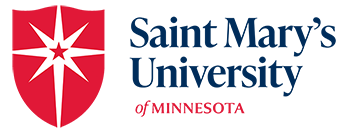Ben Preusser, a double major in physics and math, is—no surprise—interested in numbers, and he has always been a fervent fan of facts.
“(All students) should all major in physics and math; there are no other majors,” he says with a laugh.

Saint Mary’s student Ben Preusser is located toward the middle in back (wearing the Saint Mary’s shirt). He and other students pose in front of the NASA DC-8. Photo courtesy of Jane Peterson, NSERC ARC-CREST.
It could be this positive attitude, coupled with his love for learning that helped Preusser acquire a spot in the NASA Student Airborne Research Program, an eight-week summer immersion program in California.
The Saint Mary’s University senior from Belle Plaine, Minn., heard about the internship through Dr. Paul Nienaber, SJ, the Physics Department chair, who regularly sends out internship information and encourages students to apply.
Preusser said only one in eight students who applied were chosen for the unique experience.
The Student Airborne Research Program provides students with hands-on research experience in all aspects of a major scientific campaign, from detailed planning on how to achieve mission objectives to formal presentation of results and conclusions to peers and even NASA officials.
“They expose students to the whole range of collecting data, analyzing data, and presenting data,” Preusser said, explaining that the 32 students are broken down into smaller multi-disciplinary teams that study surface, atmospheric, and oceanographic processes. Preusser’s group is looking at land imagery.
The students traveled to Palmdale, Calif., and during the first two weeks, they took measurements at field sites and flew onboard the NASA DC-8, a flying laboratory, from which they sampled, collected, and measured gases at different altitudes.
Preusser said his group was fortunate to have more instrumentation on the plane than in previous years; he and other participants were exposed to as many as 20 different instruments.
Preusser’s group went up in the DC-8 during a day when smoke from a California wildfire affected their results. As a result, studying atmosphere corrections for smoke became his research project. “They have algorithms for correcting on clear air, but on one of our days, a wildfire spewed a lot of smoke on flight path. I’m looking at where in the light spectrum smoke is affecting our data and running different atmospheric corrections software to see if I find a setting that makes it look the best. It just so happened that because of our time constraint, we were presented with a unique data set to analyze how smoke is affecting our results and if it’s possible to correct that.”
For the next six weeks, teams are working at the University of California, Irvine where they are analyzing the data. Each student will then complete an individual research project from the data collected. The experience concludes with individual presentations.
Although Preusser said it’s unlikely any highly major discoveries will result from this summer’s research, the experience is invaluable.
“The program has broadened my horizons and exposed me to things I didn’t have access to,” he said. “It’s an eye opener. We have an opportunity to listen to a few NASA officials and scientists. I feel I know more about how NASA works now.”
Preusser said he felt his classes at Saint Mary’s prepared him well for the experience. “All the physics makes sense,” he said. “And the math is pretty complex but when I put in the time, it make sense. It’s hard to be completely prepared for the work that we’re doing, but I’ve learned a lot, and I don’t think the learning is done yet.”
Associate Professor of Physics Dr. Robyn Wangberg, Preusser’s academic adviser, wrote to recommend him for this position, and noted that she looks forward to Preusser’s presentation on his project fall semester at Saint Mary’s.
After completing his studies at Saint Mary’s next year, Preusser admits he isn’t sure which direction he is headed, but he is definitely interested in getting his Ph.D. He’s excited to have the internationally known and respected name of NASA on his résumé.
And, if NASA unexpectedly offered him a job, Preusser said he definitely wouldn’t decline it.
Photo caption: Senior Ben Preusser, left, takes measurement at the Sedgwick Reserve during the NASA Student Airborne Research Program. Photo courtesy of Dr. Dar Roberts, University of California, Santa Barbara.

